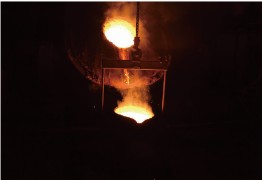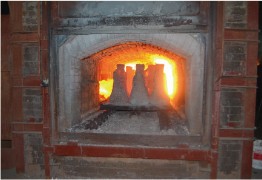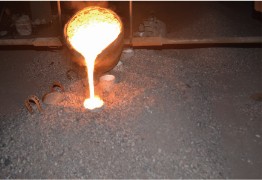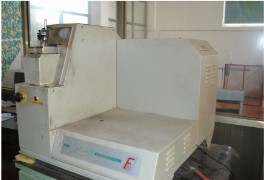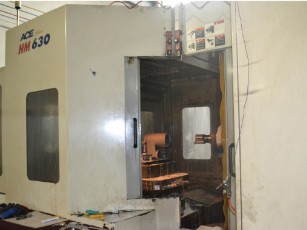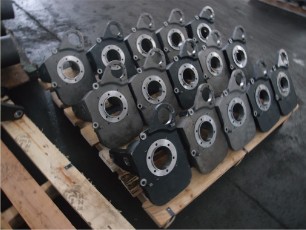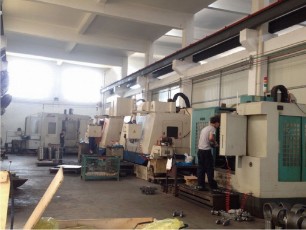Wax Mould Workshop
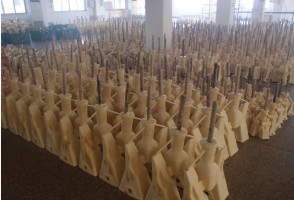
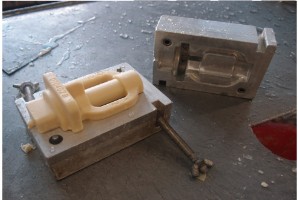
The acceptance criteria for semi-refined paraffin wax NO.58 is GB/7254-1988 and for stearic acid GB9103-88.
The wax mould workshop is kept in a bright and hygienic state with a temperature between 18-25℃. Wax moulds are acquired by pressing moulding materials into the eligible die which usually bears the duration of service, owner and date of retirement on it. Moulding materials are melt by steam vapour in a bucket where solid raw materials are added into the liquid ones at the same time. By agitating the mixture, it turns into a kind of cream paste which is later kept at a temperature from 45-50℃ for later usage.
With an internal pressure of 0.2-0.5mpa, electrothermal liquid wax injecting machine are used to inject the cream paste into the die and thus produce wax moulds. Parting medium such as transformer oil or mineral oil are applied on the inner part of the dir for the easy removal of the wax mould. After being removed from the die, the wax moulds are put into water to be cooled down so that the precise dimensions and surface smoothness are guaranteed. Then the moulds are layed on a smooth floor after being in water for more than 30 minutes. The wax moulds thus acquired may have some defects and must be repaired or further attended. Moulds with big broken corner and seriously rough surface are rejected. The flashes and burrs are trimmed with a special blade. Repair is allowed in small patches of dents provided that the mould quality is assured. After repairing, all the moulds should be rid of wax scraps and other impurities by a special brush and then they are organized in a tray. After inspection, wax moulds with the same steel designation are welded onto the wax bar in a organized way firmly, forming a cluster of wax moulds. The clusters shall be void of any wax scraps and drops and then be put on a specified area. All the wax bars are firm enough and the surface is smooth without wax scraps, holes and flashes.
Shell-making workshop
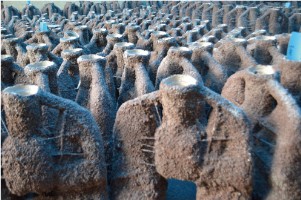
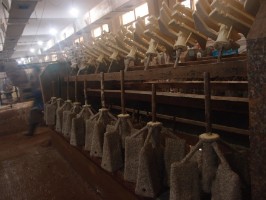
The procedure of shell making goes as follows:
1.Immerse the cluster of wax moulds into the surface coating paint;
2.Lift the cluster, wrap with quartz sand with diameter 40-70 meshes and submerge it in the induration water consisting of Ammonium Chloride for 10-20 minutes;
3.Hang it for drying for about 40 minutes;
4.Immerse it into the reinforce coating paint;
5.Wrap it with rough sand with diameter 20-40 meshes and submerge it in the induration water made of Magnesium Chloride for more than 50 minutes;
6.Hang it for drying for not more than 30 minutes;
The 4th and 5th steps should be repeated several times to reinforce the shell until the sand shell is strong enough. Ammonium The concentration of Ammonium Chloride is 17%-22%. The 1.0-1.1 densimeter is used to measure the density once a week. Magnesium Chloride is used for the induration of reinforce layer. The density is 1.22-1.24. The 1.2-1.3 densimeter is used to measure the density every three days.
Pouring Workshop
Tunnel furnaces are employed to roast the sand shells.
After a period of drying ,sand shells are then put into the tunnel furnace and roasted at a high temperature.
Sand shells are put on carts which then are pushed into the furnace for roasting.The total weight of the steel water for the shells on one cart should be equal to that of one furnace of steel water.Only shells with the same steel designation are put on the same cart. The pouring basins are forbidden to face the opening through which coals are added into the furnace .Neither are the basins allowed to face upward.
Raw material adding: first, put the clustered scraps into the smelting furnace (medium frequency electric furnace),add alloying elements if it is alloy steel,and add iron scraps until the steel liquid take up the 75% of the furnace.When the steel liquid turns white .AI wire is used for deoxidation and the steel liquid is ready for the first chemical analysis where spectrograph are employed. If the result of the first chemical analysis shows that composition conforms with what is required,than the steel liquid is ready for pouring.Or Otherwise,the composition should be adjusted by adding appropriate materials and be sent for more chemical analysis until the result shows that the composition accords with the specific steel designation.
After the adjustment of the chemical composition. The temperature is then raised up to 1630–1650℃(temperature controller is used).When the steel liquid id white with heavy smoke,press the red button to put the electric speed reducer into motion ,which can tilt the furnace, and thus the steel liquid is poured into the casting ladle.Then two men carry the ladle and pour the steel liquid into sand shells which have already been buried in the sand,at a high or low speed (as required by specific techniques). The shells are cooled in sand for20-30 minutes (determined by the physical dimension and production conditions. Generally 30 minutes for large ones and 20 minuter for smaller ones).If they are pulled out too early , deformation of hot cracking may occur;if pulled out too late, decarburized layer may occur in some castings with high carbon content.
Gas Cutting
Acetylene and oxygen are used to separate rough castings that are clustered.
Cutting guns and gas cylinders need to be checked for intactness.Based on the thickness of the ingate/riser,select the appropriate cutting nozzle and adjust the air pressure of acetylene and oxygen. While cutting,check the the ingate from time to time so that the effective part is not cut off.The cut faces should be neat. The ingate remains should be adjusted to the dimensions of the castings.Cut the riser/runner basin off the cloverleaf coupon(which is used to test the mechanical properties of the material )and divide the cloverleaf into four identical parts (test bars). The castings and their test bars are then transferred to next production procedure.All the ingates/risers that are cut off are sent to the charging material area for smelting next time. Put away all the tools when work is done.
Heat Treatment
First of all, products are classified in terms of their heat treatment techniques and transferred to the heat treatment workshop. Products that are sent into the furnace shall not exceed 1/3 of volume of the furnace. All the information, e.g. The date, should be kept down in record. Products and test bars of the same charge number are treated with the same techniques in the same furnace. All the test bars should be numbered with product names and material designations and then are sent to test their physical properties.
Shot Blasting
Ball for blasting must exceed 100KG. It is preferable that the castings to be blasted are of similar dimensions, wall thickness and weight. The length, individual weight and total weight of the castings should not exceed the respective parameters of the machine. The barrel-type cleaning machine should be set lower than the bottom of the blasting machine. The maximum length of an individual casting shall not exceed 400mm and the maximum weight of an individual casting shall not exceed 15kg. The total weight of all the castings to be blasted shall not exceed 300kg one time. Balls with different sizes are forbidden to be mixed with each other. Balls with diameter ≥2mm are forbidden to be used in apron type airless shot blasting machine. Some castings are to be specially shot blasted according to relevant techniques if the castings need to be specially processed.
Machining
Our machining capability is very strong, with a whole line of boring, milling and drilling lathes, 13 CNC lathes, 4 CNC machining centers, and related metallurgical machinery.
| Flatness (mm) | Parallelism (mm) | Symmetry (mm) | Concentricity (mm) | Perpendicularity (mm) | Circular runout (mm) | |
|---|---|---|---|---|---|---|
| Precision of our NC / CNC milling machines | 0.05 | 0.05 | 0.05 | 0.02 | 0.03/100 | 0.02 |
| Precision of our NC / CNC turning machines | 0.025 | 0.02 | 0.02 | 0.015 | 0.02/200 | 0.015 |
Finished Quality Control
We have spectrographs, metallographic analyzers, hardness testers, ultrasonic test machines, magnetic particle flaw detectors, impact testers, tension testers and other inspection instruments.
We put great emphasis on our quality control system to assure our products have the best quality. We have already passed ISO9001, TUV-PED and BV approvals.
Packaging
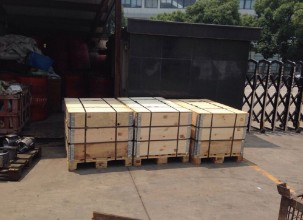
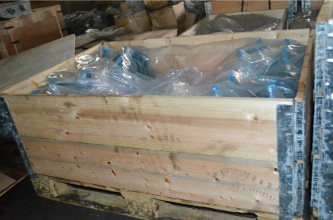
a.Wooden box with plastic bag
b.EUR-pallet with pallet collar and plastic bag

